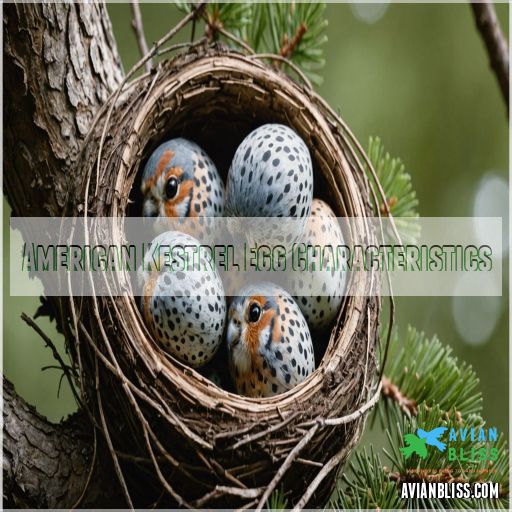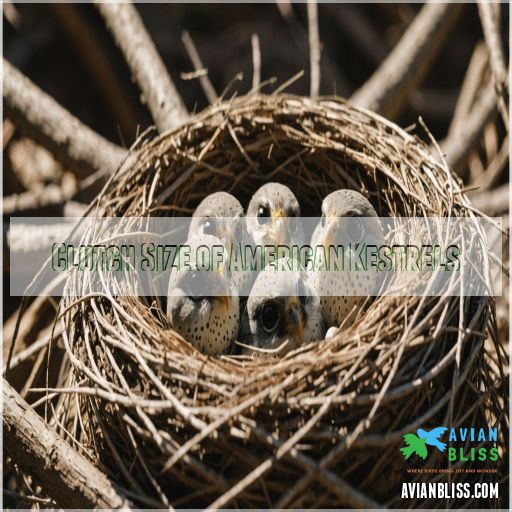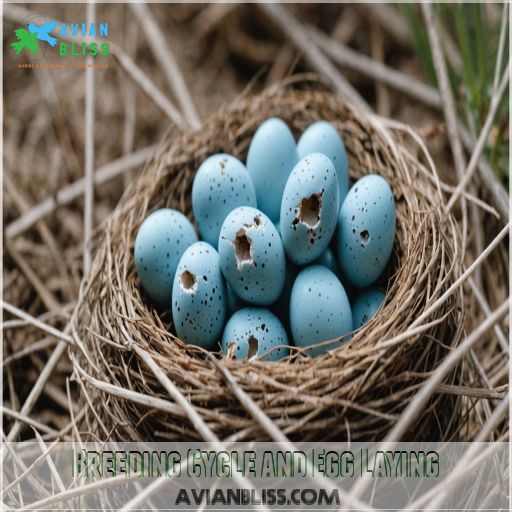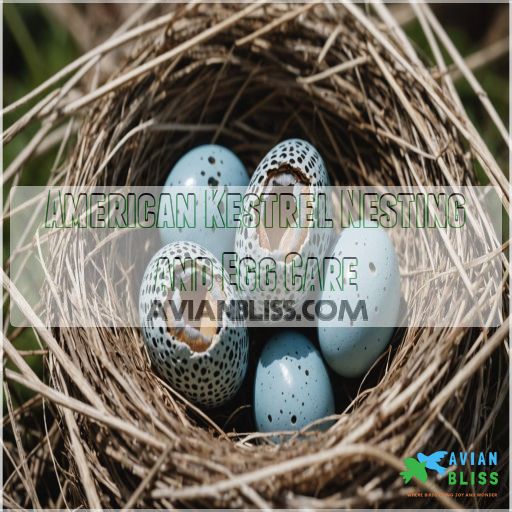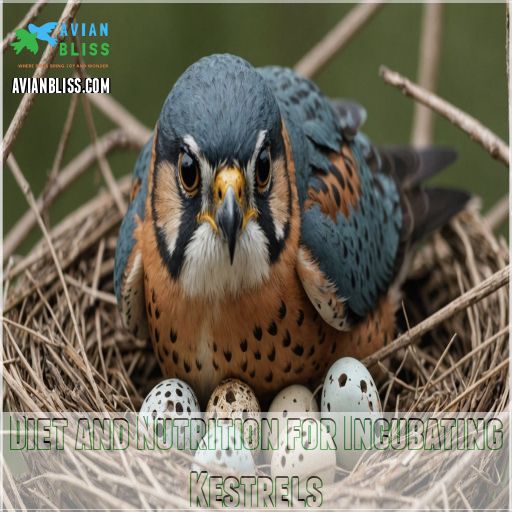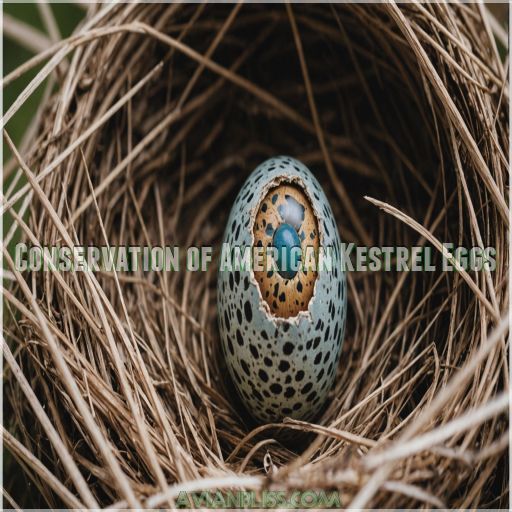This site is supported by our readers. We may earn a commission, at no cost to you, if you purchase through links.

Typically, a clutch holds about 4 to 5 eggs, but if food’s plentiful, you might see more. Incubation duties are shared, with the female doing most of the warming while the male plays waiter, delivering meals.
The whole incubation gig lasts about 26 to 32 days, and keeping the eggs at the right temperature is essential. Curious how climate change could affect our little feathered friends? Stay tuned for more information on the incubation gig.
Table Of Contents
- Key Takeaways
- American Kestrel Egg Characteristics
- Clutch Size of American Kestrels
- Incubation of American Kestrel Eggs
- Egg Laying and Latitude
- Breeding Cycle and Egg Laying
- American Kestrel Nesting and Egg Care
- Hatching of American Kestrel Eggs
- Diet and Nutrition for Incubating Kestrels
- Threats to American Kestrel Eggs
- Conservation of American Kestrel Eggs
- Frequently Asked Questions (FAQs)
- How many eggs do American kestrels lay?
- How do American kestrels incubate eggs?
- When do Kestrel eggs hatch?
- How long does a kestrel incubate?
- How long do kestrels incubate eggs?
- What is the incubation period for American kestrel?
- What color are American kestrel eggs?
- What do kestrel eggs look like?
- Why do American Kestrel eggs vary in color?
- How long after laying do kestrels incubate eggs?
- Do kestrel pairs reuse the same nest?
- What challenges do kestrel eggs face from predators?
- How does diet affect kestrel egg coloration?
- Conclusion
Key Takeaways
- You’ve got to admire the camouflage skills of American kestrel eggs. They range from white to reddish-brown with speckled patterns, blending into their surroundings like a pro. This clever disguise helps keep those sneaky predators at bay.
- When it comes to clutch size, American kestrels usually lay 4 to 5 eggs. However, if food is abundant or the neighborhood is particularly cozy, they might surprise you with a few more. It’s like a bird buffet that can influence just how many little ones they’re ready to raise.
- You might be fascinated by their incubation team effort. The female takes the lead in keeping the eggs warm and cozy, while the male swoops in like a food delivery pro. This division of labor ensures that the eggs get the right temperature, cracking open after 26-32 days.
- Curious about how egg size and location play out in the kestrel world? Eggs in northern latitudes tend to be on the heftier side compared to their southern cousins, all thanks to different latitudes and environments. It’s as if nature adjusted its ingredients to match the local recipe!
American Kestrel Egg Characteristics
When you’re checking out American Kestrel eggs, you’ll notice their colors dance between white and reddish-brown, dotted with unique patterns.
These eggs may not be the size of a chicken’s, but they pack a punch with varying sizes and weights that reflect their diverse habitats.
Eggshell Color and Patterns
American kestrel eggs are a marvel of nature’s palette, showcasing stunning color variation that ranges from creamy whites to speckled reddish-browns, all designed for camouflage. Each egg’s pattern has evolved to provide safety from predators, a true example of nature’s artistry.
- Color and Pattern: From white to reddish-brown
- Camouflage Role: Essential for protection
- Variation: Within clutches
- Evolution Significance: Aids in survival
Eggshell Thickness
Before eggshell hues dance before your eyes, picture how delicate thickness actually supports life.
Eggshell thickness varies regionally in American kestrels, whispering about environmental impacts.
Like a fortress warding off predators, it also plays into incubation success.
Imagine armor for chicks; too thin and it spells trouble.
Poisonous chemicals, like DDT, threaten this delicate balance by thinning shells.
Egg Size and Weight
Kestrel eggs vary in size and weight, influenced by latitude.
You’ll find eggs in northern regions are larger and heavier than those down south, thanks to regional differences and food availability.
With weights ranging from 9.81 to 18.6 grams, this variation highlights nature’s adaptability.
It’s like nature’s way of ensuring these eggs have a fighting chance!
Egg Shape and Form
You might be surprised by the variety of American kestrel egg shapes and forms. These fierce little falcons lay eggs that range from rounded to elongated, with a smooth, glossy texture.
The eggs can be white, cream, or light reddish-brown, often mottled with violet, gray, or brown markings. The egg size and shape are adapted to the kestrel’s agile flight habits, similar to those of bald eagle eggs, which are oval-shaped and dull white with a tan tinge, reflecting their unique nesting characteristics
.
- Egg shape variations: rounded, elongated, pointed
- Egg form function: streamlined for flight, compact for nesting
- Egg size comparison: 1.2-1.5 in long, 0.9-1.1 in wide
- Egg shell texture: smooth, glossy
Rich Adams, Rocky Mountain Eggs
Nesting Facts, American Kestrel
Clutch Size of American Kestrels
You’re curious about the American Kestrel’s clutch size, aren’t you?
These little raptors typically lay between four to five eggs.
Things like food supply and nesting sites can change that number faster than you can say "scrambled eggs.
Factors Affecting Clutch Size
American kestrels lay their eggs with variation influenced by several factors.
Food availability plays a big role—more resources mean larger clutches.
Habitat quality and nest site selection also determine how many eggs make it to incubation.
Add in the kestrel’s age and you get the picture: older birds might’ve a knack for larger families.
Climate and the timing of the breeding season affect clutch size.
Average Clutch Size
Imagine this: a typical American Kestrel clutch has 4 to 5 eggs, which seems just right for balancing family life and survival. These small falcons, scientifically known as Falco sparverius, benefit from good food availability and habitat quality.
The breeding season‘s timing and nest site can also influence clutch size.
And let’s be honest—finding eggs in nature is like nature’s Easter egg hunt!
- Food availability
- Habitat quality
- Breeding season timing
Range of Clutch Size
Imagine a treasure chest filled with surprises—American kestrels lay clutches ranging from 4 to 5 eggs, like nature’s own lottery (Source).
Factors such as food availability and nest site quality greatly influence this clutch size. Latitude also plays its part, affecting when and where these eggs are laid during the breeding season.
Sometimes kestrels even manage a second clutch, showcasing their adaptability.
Incubation of American Kestrel Eggs
When you’re thinking about how American Kestrel eggs hatch, remember both parents share the incubation duties.
With the male mainly bringing in food, it’s a cozy setup in the nest, where the eggs are tucked under warm feathers.
This arrangement ensures they stay just the right temperature for hatching success, which typically occurs after about 26-32 days.
Division of Labor Between Males and Females
In the intricate dance of kestrel parental care, females mostly handle incubation duties, warming the eggs with careful attention.
Meanwhile, male kestrels are the diligent breadwinners, swooping through the skies providing food for their nesting partners and future offspring.
This clear division of labor keeps the nest safe and sound and leads to a smooth shift from courtship display to successful hatching.
Duration of Incubation Period
You’ll be pleased to know that kestrel eggs typically take 26-32 days to incubate (Source).
This variation depends on factors like the weather and the female’s health.
Luckily, you can estimate hatch dates by checking the nest – just don’t disturb the parents too much!
With a little patience, you’ll get to witness the miracle of these tiny raptors entering the world, a truly unforgettable experience of the female’s health.
Incubation Temperature
Every American Kestrel egg needs the right incubation temperature for proper development. You’ll find the natural warmth provided by parents important, but what if variations occur? Well, it can disrupt growth!
If you’re using an incubator, remember:
- Maintain consistent heat levels.
- Monitor temperature variations closely.
- Balance natural and artificial heat.
- Keep cool! A metaphorical overheated egg isn’t a good thing.
Egg Laying and Latitude
Ever wondered why your neighborhood kestrels lay eggs earlier than those up north?
Blame it on latitude, which affects not just the timing, but also the size of the eggs they lay.
Influence of Latitude on Egg Laying
Kestrels, those compact yet mighty hunters, reveal some quirks linked to latitude.
Did you know that as you travel north, their eggs swell in size, unlike their southern cousins? It’s like a chilly migration dance—northward kestrels, bracing for cooler climates, seem to pack more into each egg.
The breeding season itself also cues to these latitude changes, impacting the hatching time dynamics.
Timing of Egg Laying in Different Regions
Latitude greatly influences when American Kestrels lay eggs.
In the southern US, they welcome spring’s first light by starting early, while their northern relatives in Canada and Alaska wait for warmer days (Source).
This variation isn’t just about the weather—migration and food availability play key roles too.
If you’re wondering, yes, kestrels are just as particular about timing as your picky neighbor scheduling a barbecue.
Effect of Latitude on Egg Size
Imagine this: evolution shapes American Kestrel eggs to adapt to geographic differences.
You’ll find:
- Egg size variation as eggs grow larger in the north.
- Latitude-driven adaptation influencing egg dimensions.
- Northern eggs boasting heftier proportions compared to those in the south.
- Evolutionary pressures impacting size due to climate and resources.
- Nature embracing locality, with eggs echoing regional flair.
It’s all about northern vs. southern adaptations!
Breeding Cycle and Egg Laying
When you’re observing American kestrels, you’ll notice that migratory ones and residents kick off their breeding cycles differently, each teaming up in unique ways.
Males perform aerial shows to woo their partners, while females decide if a second brood is on the agenda.
Initiation of Breeding Cycle in Migratory Kestrels
As the weather warms up, migratory American Kestrels start arriving at their breeding grounds.
The males scout out potential territories and nesting cavities, then wait for the females to join them.
Once reunited, the pair may settle for last year’s cavity or explore new options together.
This dance of courtship and nest selection kicks off the breeding cycle for these feisty falcons.
Initiation of Breeding Cycle in Resident Kestrels
You’re in for a treat with resident kestrels’ breeding cycle initiation. Unlike migratory ones, these kestrels embrace local life, fiercely defending their territories and picking mates with precision.
Nesting behavior reflects their commitment, as they maintain favorite sites year-round. The breeding season length depends largely on food availability, akin to a family dinner where everything hinges on what’s cooking.
Adaptation, strategy, and a sprinkle of charm define their approach, particularly during American Kestrel Courtship, which plays a significant role in their mating success.
Resident kestrels also tend to form monogamous relationships, typically sticking together for multiple breeding seasons, which helps strengthen their bond and increases their chances of successful reproduction.
Role of Males and Females in Breeding Cycle
While resident kestrels settle into their territories, male and female roles light up the stage in the breeding cycle.
Males charm their mates with courtship rituals, food sharing, and territory defense, while females excel in parental care, undertaking most incubation duties.
Males don’t just vanish; they’re busy sourcing food, proving that even in the animal world, sharing responsibilities keeps the rhythm rocking , and demonstrating that males and females both play important roles in the breeding cycle.
American Kestrel Nesting and Egg Care
You’re about to learn how American Kestrels choose nesting spots and care for their eggs, which involves tackling not just the comforts of a cozy cavity but also the challenge of keeping predators at bay.
As you explore these aspects, you might find their blend of strategy and instinct both impressive and relatable, like selecting the right spot for your own dream home, only a bit more feathered.
Their choice of nesting site is akin to finding the perfect dream home.
Nesting Sites and Materials
Choosing a cozy home is important for American Kestrels.
These resourceful birds opt for nest cavities in trees, cliff crevices, and sometimes even man-made structures like nest boxes . The entry size must snugly fit an adult kestrel, keeping rivals at bay.
Their lack of nesting material fanciness is quite enviable—they simply scratch at the debris in the cavity, a true example of Nature’s minimalists. Wouldn’t you say that this bird’s approach to nesting is admirable, and resourceful birds like the American Kestrel are a wonder to behold.
Egg Care and Incubation Techniques
American Kestrels use clever incubation techniques to keep their eggs cozy. Think of it as the art and science of egg-nurturing. Here’s a quick guide:
- Nest Site Selection: Find a safe spot, ideally a tree cavity, where the female can safely lay her clutch, which typically ranges from 2 to 5 eggs. Female kestrels often establish a pecking order among their chicks even before they hatch.
- Brood Patch Development: Warmth comes from a featherless patch on the parent’s belly. This adaptation helps in maintaining ideal incubation temperatures, important for the development of the chicks, which will initially rely on their other senses until their eyes fully open around day 1-3.
- Incubation Behavior: Rotate eggs frequently.
- Egg Turning Frequency: Turn the eggs regularly to guarantee even warmth.
Protection of Eggs From Predators
Protecting those precious eggs can feel like a high-stakes game of hide and seek!
As you watch over them, choosing the right nest site is your first line of defense.
A cavity in a dead tree or an artificial nest box keeps many predators at bay.
If the environment’s tricky, don’t hesitate to lend a helping hand with predator control methods or human intervention for nest protection.
Hatching of American Kestrel Eggs
Watching the hatching of American kestrel eggs is a mesmerizing sight.
As the chicks break free from their shells, you’ll be amazed by their determination and the care their parents provide.
Duration of Hatching Process
You’ve cared for those eggs like a pro! Now, let’s explore the moment they hatch—it’s like watching nature’s clockwork. Typically, American Kestrel eggs hatch between 30-32 days of incubation duration
.
- Hatching Timeline: Watch for those cracks around day 30.
- Hatching Variation: Some hatch faster due to environmental factors.
- Hatching Challenges: Not all hatch smoothly.
- Hatching Success: Most manage it well!
Factors Affecting Hatching Success
When those kestrel eggs finally crack open, factors like nest site quality and climate change play big roles in hatching success.
You’ve got to think about food availability; hungry parents don’t help.
Pesticide exposure can sneak up like an unpleasant surprise too.
And, let’s not forget parental care—it’s a bit like parenting with feathers. These elements all affect those tiny chicks’ chances of breaking free.
Care of Hatchlings
Hatchling development depends on parental feeding and attention.
You might say American Kestrel parents run a tight ship—feeding their chicks multiple times an hour!
Nest sanitation is key, as it keeps predators at bay and promotes healthy growth.
Brooding behavior includes keeping the hatchlings warm and cozy, much like a fluffy blanket on a cold night. It’s all about reducing predation risk and keeping them safe under brooding behavior.
Diet and Nutrition for Incubating Kestrels
You mightn’t think about it, but dinner for an incubating kestrel is no picnic.
Getting the right bugs and mice is really important.
The male’s role, like a fast-food delivery service, makes sure the female has the nutrition she needs to keep those eggs safe and warm, and this is a very important part of the male’s role.
Importance of Food for Incubating Females
During incubation, a kestrel mom’s nutritional needs skyrocket. It’s not just about sitting on eggs—she’s got to maintain her health to guarantee egg viability.
With food availability being vital, imagine her managing a hectic brood size on an empty stomach – a situation that can be particularly challenging given the impact of pesticide use and decline in insect populations affecting their food supply.
This is especially true for female American Kestrels, who often tackle larger prey than males and require powerful proteins from insects and small mammals to fuel her mission.
Besides, humorously enough, no "hangry" kestrel has ever thrived.
Role of Males in Providing Food
Imagine this: the male kestrel has a critical job when it comes to feeding.
He manages the food buffet by:
- Delivering meals frequently to the incubating female using his expert foraging strategies.
- Sharing meals through intricate food sharing dynamics.
- Ensuring each delivery’s quality impacts the female’s nutrition in the best way possible.
- Keeping a keen eye, understanding they’re more than just a pretty face in this survival dance.
Nutritional Requirements for Incubating Kestrels
As the male kestrel brings home the bacon, the female must fuel her incubation efforts. Make sure she gets a balanced diet of insects, small rodents, and even the occasional lizard or snake. Calcium is key for strong eggshells, while high-energy prey provides the calories she needs.
With the right nutrition, your kestrel chicks will hatch healthy and strong.
| Nutrient | Importance |
|---|---|
| Calcium | Supports eggshell formation |
| Protein | Fuels nestling growth |
| Vitamins | Promotes overall health |
| Water | Prevents dehydration |
| Energy | Provides heat for incubation |
Threats to American Kestrel Eggs
You might worry about the predators sneaking around American Kestrel nests, like sneaky snakes and crafty raccoons.
Besides these natural threats, you’ve got human activities and climate change adding more pressure on these eggs’ chances of survival.
Predators of American Kestrel Eggs
Imagine you’re a kestrel guarding your precious eggs. Unfortunately, a host of crafty predators, like raccoons and snakes, can’t resist a tasty egg treat.
Secure nesting sites become your first line of defense, the eggs’ mottled patterns offer nature’s camouflage.
Predator control through conservation efforts helps make sure that these beautiful raptors continue to thrive. Otherwise, your little eggs might become someone’s unwelcome breakfast!
Human Activities Affecting Egg Survival
While natural predators are a threat to kestrel eggs, human activities add another layer of challenges.
Pesticide use can harm embryos, while habitat loss leaves kestrels scrambling for nesting spots.
Then there’s nest destruction from construction and the disorienting effects of light pollution, turning nights into day for these birds.
Such disruptions can upset their natural rhythms, making egg survival as precarious as a tightrope walk.
Climate Change and Egg Survival
Human activities are just the tip of the iceberg when considering threats to kestrel eggs.
Climate change plays a significant role, altering nest site conditions and food availability, leading to mismatched timing for egg laying and hatching.
As temperatures shift like a restless toddler, kestrels struggle to adapt, impacting hatching success.
It’s a perfect storm, requiring keen observation to make sure these small falcons continue to thrive.
Conservation of American Kestrel Eggs
If you’ve ever worried about the fragile future of American kestrel eggs, practical conservation efforts offer a hopeful path forward.
By focusing on protecting nesting sites, reducing human disturbance, and spreading the word through education, you can play a part in ensuring these vibrant raptors continue to thrive.
Protection of Nesting Sites
Kestrel eggs face many threats, but protecting nesting sites can boost their chances.
You can use predator deterrents like thorny branches and smart nest box placement to keep eggs safe.
Consider habitat restoration to provide suitable nesting areas, which also lessens negative human impact.
Conservation efforts are a win-win—they help kestrels thrive and give you the joy of seeing these vibrant raptors flourish.
Reduction of Human Disturbance
You can help protect American kestrels by reducing disturbances near their nests.
Avoid approaching active nests, keep noise and light pollution to a minimum, and steer clear of areas with pesticide use.
Regularly monitor nests from a distance to make sure the birds aren’t abandoning their eggs due to stress.
These simple steps can make a big difference for these amazing falcons, and it is crucial to reduce disturbances.
Education and Outreach Programs
Reducing human disturbance is great, but you can also help American Kestrels through education and outreach.
Engage in citizen science by monitoring nests or creating habitat restoration projects. Schools might use educational materials to teach about kestrel conservation. Here’s a fun fact: students get as excited as kestrels spotting prey!
| Activity | Benefit |
|---|---|
| Nest Monitoring | Kestrel Population Data |
| Habitat Restoration | Better Nesting Sites |
| Educational Materials | Increased Awareness |
| Citizen Science | Community Engagement |
| School Programs | Youth Education |
Enjoy making a difference!
Frequently Asked Questions (FAQs)
How many eggs do American kestrels lay?
Imagine trying to juggle five balls.
American kestrels lay a clutch of 4-5 eggs, much like carefully balancing demands of parenting.
Each egg represents another delicate task these agile birds handle in their open habitat.
How do American kestrels incubate eggs?
American kestrels begin incubating once they’ve laid the third or fourth egg, taking turns sitting on the clutch mostly during the day.
Incubation lasts around 27 to 29 days, keeping those future falcons cozy and safe.
When do Kestrel eggs hatch?
Kestrel eggs usually hatch about 26-32 days after incubation begins.
The timing can vary slightly, but once you spot those adorable fluffy chicks, you know the wait was worth it.
Keep your eyes peeled!
How long does a kestrel incubate?
Did you know kestrels typically incubate their eggs for 26-32 days?
That’s a pretty long wait, but it pays off – over 80% of their eggs hatch and fledge successfully.
Just sit tight and let nature take its course!
How long do kestrels incubate eggs?
Kestrels incubate their eggs for about 26 to 32 days.
Once the third or fourth egg is laid, both parents might share incubation duties.
Ensuring those little eggs stay snug and warm until they’re ready to hatch.
What is the incubation period for American kestrel?
Imagine a tiny falcon vigil, as American kestrels cozy up on their eggs for 26-32 days.
Each day of incubation brings new anticipation, as if watching paint dry but with wings and a beak.
What color are American kestrel eggs?
American kestrel eggs come in a range of colors, from white and cream to light reddish-brown, often speckled with gray, black, and reddish spots, similar to those of other falcons in Florida
.
They’re like a nature’s paint palette, showing amazing variation.
What do kestrel eggs look like?
You’re looking at small eggs with a light pink to dark red color and speckling variations.
Each egg has its personality, like a thumbprint, influenced by the female’s diet and genetics.
Why do American Kestrel eggs vary in color?
Egg color variation in American Kestrels links to genetics, diet, and laying order.
The first egg often shows vibrant colors, while the last is paler.
Female health during laying plays a big role too.
How long after laying do kestrels incubate eggs?
Kestrels start incubating their eggs once the third one is laid, but sometimes you might catch them sitting earlier.
This process lasts around 27 to 32 days before the eggs hatch into hungry chicks.
Do kestrel pairs reuse the same nest?
Imagine a tiny falcon, flitting from tree to tree, making its home in the same cozy cavity year after year.
Indeed, American kestrels often reuse their nests, a clever adaptation that saves time and energy.
What challenges do kestrel eggs face from predators?
Kestrel eggs face threats from various predators like snakes, raccoons, and larger birds.
Nature’s drama plays out as parents fiercely defend their nest.
Sometimes they outwit predators by cleverly choosing well-hidden nesting sites.
How does diet affect kestrel egg coloration?
Like a painter’s varied palette, a kestrel’s diet can influence egg color.
Nutrient-rich meals make pigments more vibrant, while a poor diet might dull them.
It’s a neat way nutrition shakes up nature’s artwork.
Conclusion
Have you ever pondered how American kestrel eggs’ characteristics reflect their survival needs?
These adaptations mean that the clutch size and incubation details align perfectly with their natural environment.
As you explore these eggs, consider the role each factor plays, from sharing incubation duties to the influence of climate change on the incubation process.
Your insights might help preserve these fascinating birds, reminding us that every detail, big or small, contributes to their ongoing survival.

